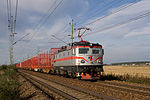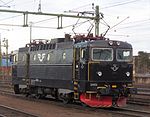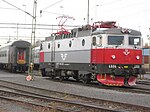SJ Rc
This article relies largely or entirely on a single source. (January 2012) |
| Rc | |||||||||||||||||||
|---|---|---|---|---|---|---|---|---|---|---|---|---|---|---|---|---|---|---|---|
 Rc6 operated by SJ | |||||||||||||||||||
| |||||||||||||||||||
| |||||||||||||||||||
| |||||||||||||||||||
The Rc class is the most used electric locomotive in Sweden. Built by Allmänna Svenska Elektriska Aktiebolaget (ASEA), the Rc is a universal locomotive used both in freight and passenger trains. The largest operator is Green Cargo, although SJ, Tågab, Hector Rail and Banverket operate it as well. Previous operators include Veolia Transport.
History
[edit]The Rc-model emerged from ASEA in the 1960s. It first appeared in 1967 to replace the older D-locomotives. Notably, ASEA facility manager and head engineer Tore Nordin was involved in designing and developing the Rc locomotive at ASEA.[1] The initial Rc models are notable for using thyristors instead of the older relay-based system.
As of 2020, Rc-locomotives are still used all over Sweden in both passenger and freight lines, although on passenger trains they are slowly being replaced by new EMU, such as ER1.
Versions
[edit]Altogether, there have been eight versions of the Rc-locomotive in Sweden, including the freight locomotive Rm designed to pull iron ore trains. Rc1, Rc2, Rc4, and Rc5 have a maximum allowed speed of 135 km/h. Rc3 and Rc6 have a maximum allowed speed of 160 km/h. Rc7 was a rebuild of Rc6 meant to haul replacement trains needed when the X 2000 trains were canceled or delayed. Rc7 had a maximum allowed speed of 180 km/h. However, the maximum speed permitted without emergency electromagnetic track brakes is 160 km/h, and keeping extra carriages was considered too expensive. For that reason all Rc7 were subsequently converted back to Rc6. Rc1–Rc7 all weigh between 75 and 80 tonnes, whilst the Rm weighs 90 tonnes. The Rm's top speed is only 100 km/h and are more powerful locomotives.
Exports
[edit]Engines based on the Rc design were sold to other countries. ÖBB bought 10 Rc2 with extra brakes for the alpine conditions, ÖBB Class 1043. One of the locos was badly damaged in an accident but the remaining nine have been bought by the Swedish company Tågåkeriet i Bergslagen AB (TÅGAB), and returned to Sweden.[2] A slightly altered Rc4 has been sold to Norwegian State Railways of Norway, known as El 16. The RAI 40-700 class (see Iranian Railways RC4) of eight engines were exported to Iran in the early eighties for use on the electrified stretches near the then-Soviet border; these were based on Rc4 but with Rm-type bogies, sand-proof air filters and no round windows on the side. In 1977, an Rc4 was tested in the United States for use with Amtrak's passenger trains, designated as X995. The Rc4 engine proved successful and would become the basis for the AEM-7.
Refurbished units
[edit]42 class Rc2 locomotives have been refurbished by Bombardier for Green Cargo. They include various upgrades and are now known as class Rd2.[3]
| Model | Operator | Built | Years | Power | Top speed | Note |
|---|---|---|---|---|---|---|
| SJ Rc1 | Green Cargo, Tågab, | 20 | 1967–68 | 3,600 kW | 135 km/h | Last Rc1 retired from Green Cargo in 2015. |
| SJ Rc2 | Green Cargo, Tågab, Infranord | 100 | 1969–75 | 3,600 kW | 135 km/h | Green Gargo Rc2 refurbished to Rd2, last one in 2014. |
| SJ Rc3[4] | SJ AB and Green Cargo Hector Rail (which renamed them to type 143) |
33 | 1970–71 | 3,600 kW | 160 km/h | 23 rebuilt from Rc2, 13 later sold to Green Cargo and Hector Rail. Last Rc3 sold by SJ in 2013. |
| ÖBB Class 1043 | Tågab and Swedish Rail Administration and TGOJ | 9 | 1971–73 | 4,000 kW | 135 km/h | |
| SJ Rc4 | Green Cargo | 130 | 1975–82 | 3,600 kW | 135 km/h | 160 km/h for Rc4P |
| SJ Rm | Green Cargo | 6 | 1977 | 3,600 kW | 100 km/h | Cargo-only locomotives, originally for use on the Ore Route, now used all over Sweden. |
| NSB El 16 | CargoNet | 17 | 1977–84 | 4,440 kW | 135 km/h | |
| AEM-7 | Amtrak, SEPTA, MARC | 65 | 1978–88 | 5,200 kW | 200 km/h | Retired with original operators since 2018, 6 SEPTA units on temporary lease with NJ Transit Rail Operations but never used and later returned. |
| RAI 40-700 class | Islamic Republic of Iran Railways | 8 | 1982 | 3,600 kW | 100 km/h | |
| SJ Rc5 | Swedish Transport Administration (("SSRT") owner without own operation) | 60 | 1982–86 | 3,600 kW | 135 km/h | All now converted into Rc6 |
| SJ Rc6 | SJ AB and Swedish Transport Administration (("SSRT") owner without own operation) | 100 | 1982–86 | 3,600 kW | 160 km/h | 60 converted from Rc5 |
| SJ Rc7 | SJ AB | 2 | 2001 | 3,600 kW | 180 km/h | Rebuilt from Rc6, all now converted back to Rc6 |
| ALP-44 | ABB Traction | 33 | 1989-1997 | 4,320 kW | 201 km/h | Built from AEM-7 and SJ Rc7 for NJ Transit; 2308 sent to SEPTA as a lawsuit settlement; Retired on NJT by 2012 and SEPTA by 2018. |
Gallery
[edit]-
Rc2 1007 on a test run in January 1967
-
Two Rc4 and a Rc2 (in the middle) of Green Cargo
-
Banverket construction train hauled by a formerly Austrian Rc2 engine
-
TÅGAB Rc2 (also ex-ÖBB) with an empty wood train near Hallsberg.
-
Rc4 in heritage SJ colors, owned by Green Cargo.
-
Rc6 in the new black SJ livery, at Luleå C
-
Rc6 in silver-and-red SSRT livery, operated by SJ, at Luleå C
References
[edit]- ^ "Rc-loket firar 50 år". Retrieved 2023-03-28.
- ^ End of Class 1043 Modern Railways issue 639 December 2001 page 60
- ^ "Railway Gazette: Modernised locomotives handed over to Green Cargo". Retrieved 2010-11-28.
- ^ "CLASS 143 – THE CLASSIC – Hector Rail" (in Swedish). Retrieved 2021-10-10.
External links
[edit]- Järnväg.net on Rc (in Swedish)
- Photos of various Rc locomotives







